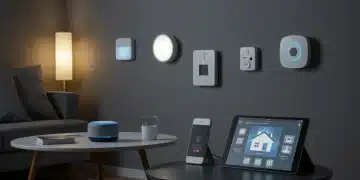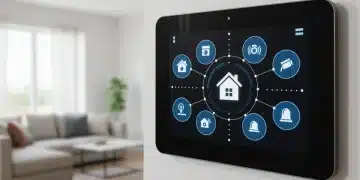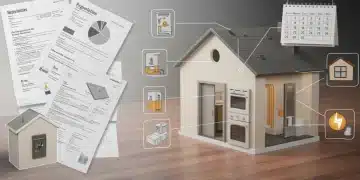Smart Home Maintenance: 2025 Seasonal Checklist for Optimal Performance
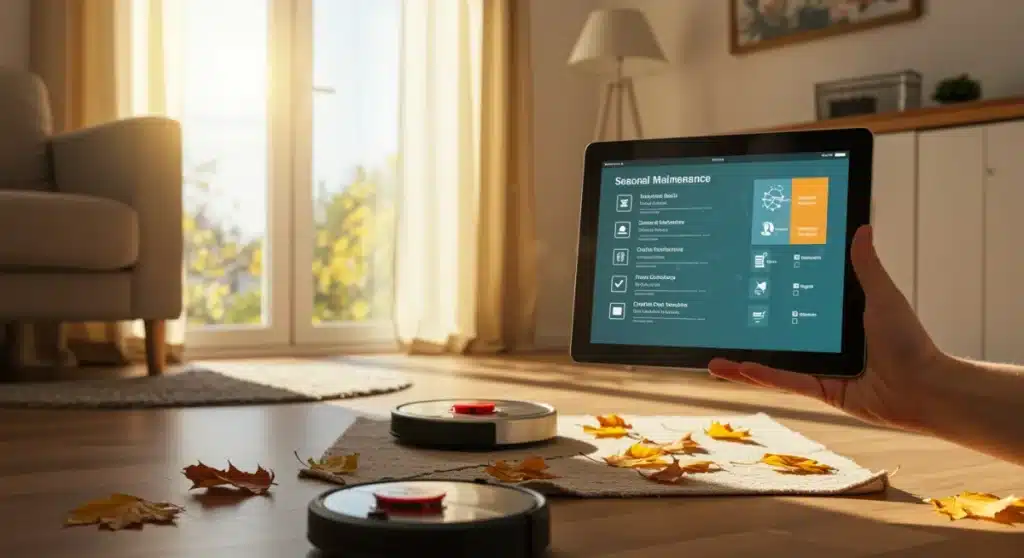
Smart Home Maintenance: A Seasonal Checklist for Optimal Performance in 2025 (TIME-SENSITIVE) outlines critical, timely steps for homeowners to ensure their integrated systems operate efficiently and securely throughout the upcoming year.
As 2025 approaches, ensuring your Smart Home Maintenance: A Seasonal Checklist for Optimal Performance in 2025 (TIME-SENSITIVE) is up-to-date becomes paramount. This proactive approach guarantees your connected devices continue to function flawlessly, providing convenience and security. What specific actions should homeowners be taking now to prepare for the year ahead?
Understanding the Evolving Smart Home Landscape in 2025
The smart home ecosystem is continuously evolving, with new devices, software updates, and security threats emerging at a rapid pace. For homeowners, this means that maintenance is no longer a one-time task but an ongoing, dynamic process. The year 2025 brings with it advancements in AI integration and enhanced interoperability, making regular check-ups more crucial than ever.
Keeping pace with these changes ensures that your smart home remains efficient, secure, and responsive to your needs. Neglecting maintenance can lead to performance degradation, security vulnerabilities, and even system failures, undermining the very benefits smart technology promises.
Key Trends Shaping 2025 Smart Homes
Several key trends are defining the smart home landscape in 2025, impacting how we approach maintenance. Understanding these trends helps homeowners prioritize their actions.
- AI-Powered Automation: Increased reliance on artificial intelligence for predictive maintenance and personalized automation.
- Enhanced Security Protocols: More sophisticated cybersecurity measures are required to protect against evolving threats.
- Interoperability Standards: Greater emphasis on universal communication standards like Matter, simplifying device integration but requiring consistent firmware updates.
- Energy Efficiency Focus: Smart systems are increasingly designed to optimize energy consumption, making calibration and sensor cleaning vital.
These developments underscore the need for a comprehensive and timely maintenance strategy, moving beyond simple device reboots to more strategic system management.
Winter Preparations: Securing Your Smart Home Against the Cold
As winter approaches, preparing your smart home for colder temperatures and potential adverse weather conditions is essential. This seasonal focus ensures your heating systems operate efficiently and your outdoor devices withstand harsh elements. Proactive measures now can prevent costly issues later.
The focus during winter preparation shifts towards energy management and the resilience of external smart devices. From smart thermostats to outdoor cameras, each component plays a role in maintaining comfort and security during the colder months.
Optimizing Smart Thermostats and Heating Systems
Your smart thermostat is central to winter energy efficiency. Proper calibration and integration with other smart home systems can lead to significant savings and comfort.
- Calibration Check: Verify your smart thermostat’s temperature readings against a traditional thermometer to ensure accuracy.
- Schedule Review: Adjust heating schedules to align with winter routines, prioritizing energy conservation during unoccupied periods.
- Sensor Cleaning: Clean any dust or debris from remote temperature sensors to ensure accurate environmental monitoring.
Beyond thermostats, consider checking smart vents and zonal heating controls for proper function. Ensuring all components of your smart heating system are working in harmony is key to an efficient winter.
Protecting Outdoor Smart Devices
Outdoor smart devices, such as security cameras, smart lighting, and smart sprinkler controllers (even if turned off), require special attention to prevent damage from snow, ice, and extreme cold.
Inspect all outdoor device housings for cracks or wear that could expose internal components to moisture. Ensure seals are intact and mounting brackets are secure. For battery-powered devices, monitor battery levels closely as cold weather can significantly reduce performance and lifespan. Consider bringing in any non-essential outdoor devices that are not rated for extreme temperatures.
Spring Cleaning: Refreshing Your Smart Home Ecosystem
With the arrival of spring, it’s time to refresh your smart home, focusing on connectivity, sensor functionality, and general cleanliness. This period is ideal for addressing issues that may have arisen during winter and preparing for warmer weather operations. A thorough spring cleaning can significantly enhance device performance and extend their lifespan.
This seasonal refresh goes beyond mere dusting; it involves systematic checks of network health, device updates, and sensor calibration. Ensuring every component is clean and updated is fundamental for optimal operation.
Network Health and Device Updates
A robust Wi-Fi network is the backbone of any smart home. Spring is an excellent time to assess your network’s performance and ensure all devices are running the latest software versions.
- Router Reboot: Perform a full power cycle of your Wi-Fi router and any mesh network satellites to clear minor glitches and optimize performance.
- Firmware Updates: Check for and install firmware updates for all smart devices, including hubs, cameras, and smart appliances, to patch security vulnerabilities and add new features.
- Password Review: Update Wi-Fi and device passwords, especially if they haven’t been changed in over six months, to bolster security.
Additionally, consider reviewing your network’s channel usage to mitigate interference, especially if you experience slow speeds or dropped connections. Tools are available to analyze Wi-Fi channel congestion and recommend optimal settings.
Sensor Cleaning and Calibration
Dust and debris can accumulate on smart sensors, affecting their accuracy and responsiveness. Spring cleaning should include a thorough check and cleaning of all environmental and motion sensors.
Clean smart home sensors such as those on smart thermostats, motion detectors, and air quality monitors with a soft, dry cloth. For devices like robot vacuums, empty dustbins, clean brushes, and wipe down external sensors. Calibrate any sensors that offer this function, ensuring they provide accurate data for your automated routines. This attention to detail prevents erroneous readings and ensures your smart home responds correctly to its environment.
Summer Optimizations: Enhancing Comfort and Efficiency
Summer brings unique challenges and opportunities for smart home optimization. The focus shifts to cooling efficiency, outdoor entertainment, and vacation security. Leveraging your smart home’s capabilities during these months can lead to greater comfort and peace of mind.
As temperatures rise, ensuring your cooling systems and outdoor smart devices are performing at their best becomes critical. This period also calls for robust security measures if you plan to travel, making your smart home an active protector of your property.
Smart Cooling and Air Quality Management
Maximizing the efficiency of your smart air conditioning and ventilation systems is paramount during summer. Integration with weather data and occupancy sensors can lead to significant energy savings.
- AC Integration: Ensure your smart thermostat is effectively communicating with your AC unit for optimal cooling cycles.
- Fan Optimization: Utilize smart fans and ceiling fans in conjunction with your AC to improve air circulation and reduce cooling load.
- Air Quality Monitoring: Check smart air purifiers and monitors, replacing filters as needed to maintain healthy indoor air quality.
Consider programming your smart blinds or shades to automatically close during peak sunlight hours, further reducing heat gain. This coordinated effort helps keep your home cool without excessive energy consumption.
Outdoor Living and Vacation Security
Summer often means more time spent outdoors and potential travel. Your smart home can enhance both experiences through entertainment and advanced security.
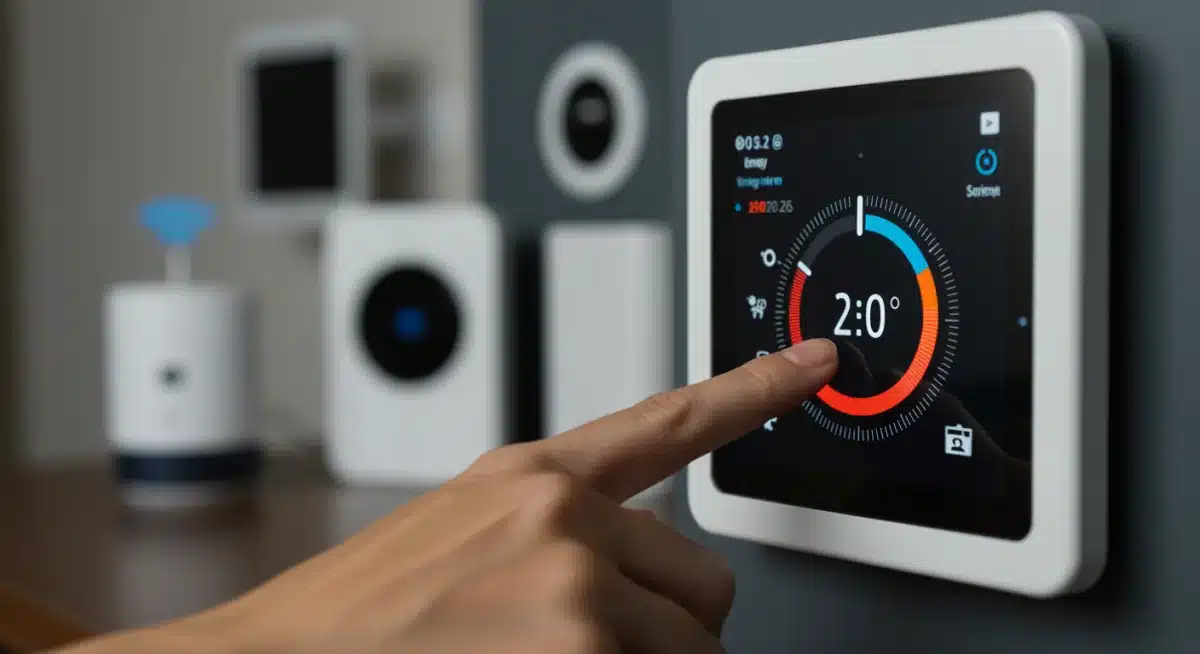
For outdoor living, verify the functionality of smart outdoor lighting, smart speakers, and smart irrigation systems. Ensure they are correctly scheduled and connected. For vacation security, activate away modes on your smart security system, test smart locks, and verify remote access to cameras. Consider setting up smart lighting routines to simulate occupancy, deterring potential intruders. This layered approach to security provides peace of mind while you’re away.
Autumn Audits: Preparing for the Transition
Autumn serves as a crucial transitional period, requiring a thorough audit of your smart home systems to prepare for the colder months ahead. This phase focuses on energy efficiency, system recalibration, and reinforcing security. Addressing these aspects now can prevent problems as winter approaches.
This season is about proactive checks and adjustments, ensuring that your smart home is not only ready for changing weather but also operating at its peak efficiency before the full onset of winter’s demands. It’s a critical time for preventative maintenance.
Energy Efficiency and System Recalibration
With heating systems soon to be in constant use, an autumn audit of energy-related smart devices is vital. Recalibrating sensors and reviewing automation rules can lead to substantial savings.
- Thermostat Recalibration: Re-check your smart thermostat’s calibration and ensure it’s ready for heating cycles.
- Window/Door Sensors: Verify that all smart window and door sensors are functioning correctly to prevent heat loss from open entry points.
- Smart Plug Review: Audit smart plugs to ensure they are only powering essential devices during peak heating periods or when needed.
Additionally, inspect smart lighting schedules. Adjust them to account for shorter daylight hours, ensuring your home is well-lit when you need it without wasting energy. This careful review of energy consumption patterns can uncover areas for optimization.
Security Reinforcement and Device Health Checks
Autumn is an opportune time to reinforce your smart home’s security posture and conduct thorough health checks on all devices. As people spend more time indoors, ensuring system reliability is key.
Test all smart security cameras, ensuring clear feeds and motion detection. Check smart lock batteries and lubricate mechanisms if necessary. Review your smart home hub’s activity logs for any unusual patterns or errors. This period is also ideal for backing up smart home configurations, especially if you plan any significant system upgrades or additions. A comprehensive health check now can prevent unexpected failures during the busiest times of the year.
Cybersecurity and Privacy: An Ongoing Commitment in 2025
In 2025, cybersecurity and privacy are not seasonal tasks but an ongoing, year-round commitment for smart home owners. With the increasing sophistication of cyber threats and the growing amount of personal data collected by smart devices, vigilance is paramount. Regular security audits and adherence to best practices are essential to protect your digital life.
The interconnectedness of smart devices means a single vulnerability can compromise your entire system. Therefore, a proactive and continuous approach to cybersecurity is non-negotiable for maintaining a secure and private smart home environment.
Best Practices for Digital Security
Implementing strong digital security practices is the first line of defense against cyber threats. These practices should be ingrained in your routine smart home management.
- Strong, Unique Passwords: Use complex, unique passwords for every smart device and Wi-Fi network. Consider a password manager.
- Two-Factor Authentication (2FA): Enable 2FA wherever possible, especially for critical accounts linked to your smart home hub or devices.
- Network Segmentation: If possible, create a separate Wi-Fi network for your smart devices (IoT network) to isolate them from your main personal devices.
Regularly review the permissions granted to smart home apps and revoke access for those that are no longer necessary or seem overly intrusive. Stay informed about common phishing scams and never click on suspicious links related to your smart home accounts.
Privacy Settings and Data Management
Understanding and managing the privacy settings of your smart devices is crucial for protecting your personal data. Many devices collect data on usage, location, and even voice commands.
Periodically review the privacy policies of your smart device manufacturers and adjust settings to limit data collection where possible. Be aware of what data is being shared and with whom. Disable features you don’t use that might collect unnecessary data, such as always-on microphones or location tracking. Regularly delete old recordings from smart cameras and doorbells if they are stored in the cloud, adhering to your device’s data retention policies. Your privacy in a smart home environment is largely within your control, provided you actively manage it.
Future-Proofing Your Smart Home: Beyond 2025
As we navigate through 2025, the concept of future-proofing your smart home goes beyond mere maintenance; it involves strategic planning for longevity, compatibility, and adaptability. The rapid pace of technological innovation means that today’s cutting-edge device could be obsolete tomorrow. Therefore, homeowners must consider future trends and make informed decisions to ensure their smart home investments remain valuable and functional for years to come.
This forward-thinking approach focuses on selecting devices with open standards, investing in modular systems, and staying informed about emerging technologies. It’s about building a smart home that can evolve with technology, rather than being replaced by it.
Investing in Open Standards and Modular Systems
One of the most effective ways to future-proof your smart home is to prioritize devices that adhere to open standards and are part of modular systems. This approach minimizes the risk of vendor lock-in and ensures greater flexibility.
- Matter and Thread Compatibility: Opt for devices that support emerging open standards like Matter and Thread, which promise enhanced interoperability across different brands.
- Modular Design: Choose systems that allow for easy expansion and upgrades, rather than monolithic solutions that are difficult to modify.
- Cloud Independence: Where possible, select devices that offer local control options or can function without constant cloud connectivity, reducing reliance on manufacturer services.
This strategy ensures that your smart home can integrate new technologies as they emerge and is less susceptible to issues arising from a single manufacturer discontinuing support for their products. It provides a foundation for long-term adaptability.
Staying Informed and Adapting to New Technologies
The smart home market is dynamic, with new innovations constantly appearing. Staying informed about these developments is key to making timely upgrades and maintaining a cutting-edge smart home.
Subscribe to reputable tech news outlets, follow industry blogs, and attend virtual expos to keep abreast of the latest advancements in smart home technology. Be prepared to adapt your existing setup to incorporate new devices or software that offer significant improvements in security, efficiency, or functionality. This proactive engagement with the evolving landscape ensures that your smart home remains relevant and performs optimally not just in 2025, but well into the future, maximizing its value and convenience.
| Key Point | Brief Description |
|---|---|
| Seasonal Checks | Implement a quarterly maintenance routine for optimal device performance and longevity. |
| Cybersecurity | Regularly update firmware, use strong passwords, and manage privacy settings for enhanced security. |
| Energy Efficiency | Calibrate smart thermostats and optimize schedules to reduce energy consumption year-round. |
| Future-Proofing | Invest in open-standard, modular devices to ensure long-term compatibility and adaptability. |
Frequently Asked Questions About Smart Home Maintenance
Seasonal maintenance is critical because of rapid technological advancements and evolving security threats. Regular checks ensure devices remain updated, secure, and perform optimally against seasonal environmental changes, preventing costly malfunctions and extending their lifespan throughout 2025.
It is recommended to check for and install firmware updates at least quarterly, ideally during seasonal maintenance checks. This ensures you have the latest security patches and feature enhancements, protecting your devices from vulnerabilities and improving functionality.
Key steps include using strong, unique passwords, enabling two-factor authentication, and regularly updating firmware. Consider network segmentation to isolate smart devices. Regularly review privacy settings and app permissions to control data sharing and enhance overall digital security.
Improve energy efficiency by calibrating smart thermostats, optimizing heating/cooling schedules based on occupancy and weather, and using smart plugs to manage power consumption. Regularly clean sensors for accurate readings and integrate smart blinds to control natural light and temperature.
Future-proofing means investing in devices that support open standards like Matter and Thread, opting for modular systems, and prioritizing local control over cloud dependence. It ensures your smart home remains compatible with new technologies and adaptable to future innovations, maximizing long-term value.
Looking Ahead: The Evolving Smart Home Standard
The landscape of smart home technology in 2025 is not static; it is a fluid environment shaped by rapid innovation and increasing user demand for seamless integration and robust security. What this means for homeowners is a continuous need for adaptability and informed decision-making. The ongoing push for universal standards like Matter will likely simplify device management, but it also necessitates a keen eye on compatibility and timely updates. Expect to see further developments in AI-driven predictive maintenance, allowing homes to anticipate and address issues before they become critical. Homeowners should prepare for a smart home experience that is increasingly autonomous, personalized, and, crucially, secure, requiring a commitment to the annual maintenance rhythm we’ve outlined. The next few years will undoubtedly bring even more sophisticated solutions, making proactive maintenance not just a recommendation, but a necessity for optimal living.
